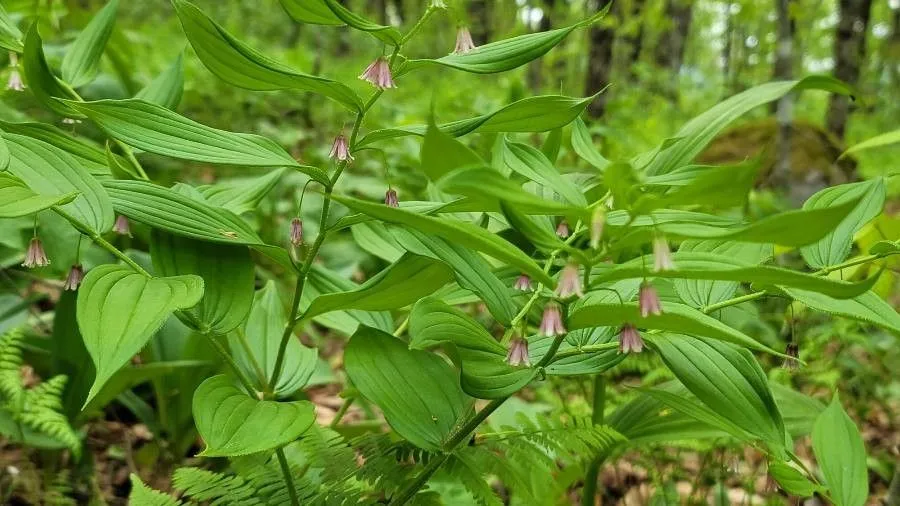
Author: (Aiton) Reveal
Bibliography: Phytologia 74: 187 (1993)
Year: 1993
Status: accepted
Rank: species
Genus: Streptopus
Vegetable: False
Observations: Alaska to NW. U.S.A., C. & E. Canada to North Carolina
Twistedstalk, known scientifically as Streptopus lanceolatus, is a fascinating and unique member of the Liliaceae family. Described in Phytologia in 1993 by botanist Aiton and later revised by Reveal, this plant possesses a combination of subtle beauty and intriguing botanical characteristics.
Geographical Distribution:
Twistedstalk is widely distributed across various regions—spanning from Alaska through the Northwestern United States and extending over Central and Eastern Canada. This resilient species can also be found as far south as North Carolina. Its broad range highlights its adaptability to diverse climates and environments.
Morphological Features:
The plant is characterized by its slender, often twisted stems, which give the species its common name. The stems bear alternating leaves that are broadly lance-shaped, a feature encapsulated in its species name lanceolatus. The leaves typically exhibit a bright green hue and are slightly serrated at the edges, enhancing their visual appeal.
A particularly striking feature of Twistedstalk is its flowers. They are small and nodding, usually hanging singly or in pairs from the axils of the leaves. The blooms are bell-shaped and can range in color from white to light pink, with delicate, sharply curved tips. Following flowering, the plant produces small, berry-like fruits that are red when ripe.
Growth and Habitat:
Twistedstalk thrives in moist, shaded environments commonly found in deciduous and mixed forests. It is often seen growing along stream banks, on the forest floor in rich, moist soil, or even nestled in the cool, damp understory of wooded areas. The plant prefers cooler environments, which is consistent with its presence in northern latitudes and higher altitudes within its range.
Ecological Role:
Twistedstalk plays a vital role in its ecosystem. Its flowers are an important nectar source for a variety of pollinators, including bees and butterflies. The berries, which ripen in late summer to early fall, serve as a food source for birds and small mammals, contributing to the forest’s food web.
Human Uses and Cultural Significance:
Historically, indigenous peoples and early settlers valued the Twistedstalk plant for its medicinal properties. The plant parts, including leaves and berries, were utilized in traditional remedies. However, it is essential to note that some parts of the plant may be mildly toxic if ingested in large quantities.
In summary, Streptopus lanceolatus or Twistedstalk is a remarkable plant notable for its twisted stems, delicate flowers, and adaptability to various North American climates. Its presence across a broad geographical area underscores its ecological significance and resilience, making it an interesting subject of study and a cherished component of the plant kingdom.
Eng: twistedstalk, rose twisted-stalk, rose mandarin, rosy twisted-stalk, sessile-leaved twisted-stalk, simple-stemmed twisted-stalk
Swe: rosa skruvrams
Fra: streptope rose
En: Twistedstalk, Rose twisted-stalk, Rose mandarin, Rosy twisted-stalk, Sessile-leaved twisted-stalk, Simple-stemmed twisted-stalk
Fr: Streptope rose
Sv: Rosa skruvrams
Taken Nov 24, 2014 by EOL − Evan Raskin (cc-by-nc)
Taken May 5, 2013 by EOL − Bob Heitzman (cc-by-nc)
Taken Jul 29, 2013 by EOL − Kyle Jones (cc-by-nc)
Taken Jun 1, 2014 by EOL − Charlie Hohn (cc-by-nc)
Taken Oct 28, 2022 by Thomas Zhu (cc-by-sa)
Taken May 28, 2021 by Vicki Brown (cc-by-sa)
Taken Jan 17, 2015 by EOL − podiceps (cc-by-nc)
Taken Nov 24, 2014 by EOL − Evan Raskin (cc-by-nc)
Taken Nov 24, 2014 by EOL − Evan Raskin (cc-by-nc)
Taken Nov 24, 2014 by EOL − Evan Raskin (cc-by-nc)
Taken May 21, 2014 by EOL − Evan Raskin (cc-by-nc)
Taken Jul 10, 2015 by EOL − anewman (cc-by-nc)
Taken Jul 10, 2015 by EOL − anewman (cc-by-nc)
Taken Jan 1, 1900 by EOL − Walter Siegmund (cc-by-sa)
Taken Jan 1, 1900 by EOL − Superior National Forest (cc-by)
Taken Jul 29, 2013 by EOL − Kyle Jones (cc-by-nc)
Taken May 21, 2015 by EOL − Paul Norwood (cc-by-nc)
Taken Jan 7, 2015 by EOL − Scott Schuette (cc-by-nc)
Taken Jun 7, 2000 by EOL − Charles Webber (cc-by-nc-sa)
Taken Jul 4, 2013 by EOL − john hannah (cc-by-nc)
Taken Jun 1, 2014 by EOL − Charlie Hohn (cc-by-nc)
Growth habit>: Forb/herb
Family: Myrtaceae Author: (F.Muell.) K.D.Hill & L.A.S.Johnson Bibliography: Telopea 6: 402 (1995) Year: 1995 Status:…
Family: Rubiaceae Author: Pierre ex A.Froehner Bibliography: Notizbl. Bot. Gart. Berlin-Dahlem 1: 237 (1897) Year:…
Family: Sapindaceae Author: Koidz. Bibliography: J. Coll. Sci. Imp. Univ. Tokyo 32(1): 38 (1911) Year:…
Family: Asteraceae Author: A.Gray Bibliography: Pacif. Railr. Rep.: 107 (1857) Year: 1857 Status: accepted Rank:…
Family: Fabaceae Author: Medik. Bibliography: Vorles. Churpfälz. Phys.-Ökon. Ges. 2: 398 (1787) Year: 1787 Status:…
Family: Aspleniaceae Author: (Cav.) Alston Bibliography: Bull. Misc. Inform. Kew 1932: 309 (1932) Year: 1932…